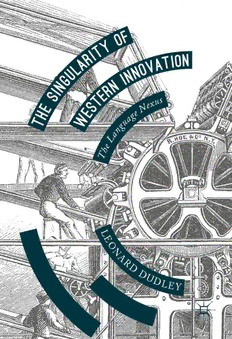
The Singularity of Western Innovation : The Language Nexus PDF
Preview The Singularity of Western Innovation : The Language Nexus
f o Y T I R t i o n A a v L o n U n G I n N r I e S t E s u s x e e H N W e T g a u g n a L e h T L E O N A R D D U D LEY The Singularity of Western Innovation Leonard Dudley The Singularity of Western Innovation The Language Nexus LeonardDudley Montreal,Canada ISBN978-1-137-40317-9 ISBN978-1-137-39822-2 (eBook) DOI10.1057/978-1-137-39822-2 LibraryofCongressControlNumber:2017946893 ©TheEditor(s)(ifapplicable)andTheAuthor(s)2017 Thisworkissubjecttocopyright.AllrightsaresolelyandexclusivelylicensedbythePublisher, whetherthewholeorpartofthematerialisconcerned,specificallytherightsoftranslation, reprinting,reuseofillustrations,recitation,broadcasting,reproductiononmicrofilmsorinany otherphysicalway,andtransmissionorinformationstorageandretrieval,electronicadaptation, computersoftware,orbysimilarordissimilarmethodologynowknownorhereafterdeveloped. Theuseofgeneraldescriptivenames,registerednames,trademarks,servicemarks,etc.inthis publicationdoesnotimply,evenintheabsenceofaspecificstatement,thatsuchnamesare exemptfromtherelevantprotectivelawsandregulationsandthereforefreeforgeneraluse. Thepublisher,theauthorsandtheeditorsaresafetoassumethattheadviceandinformationin thisbookarebelievedtobetrueandaccurateatthedateofpublication.Neitherthepublisher northeauthorsortheeditorsgiveawarranty,expressorimplied,withrespecttothematerial contained herein or for any errors or omissions that may have been made. The publisher remains neutral with regard to jurisdictional claims in published maps and institutional affiliations. Coverimage©FALKENSTEINFOTO/AlamyStockPhoto CoverdesignbySamanthaJohnson Printedonacid-freepaper ThisPalgraveMacmillanimprintispublishedbySpringerNature TheregisteredcompanyisNatureAmericaInc. Theregisteredcompanyaddressis:1NewYorkPlaza,NewYork,NY10004,U.S.A. P REFACE OnthebookshelfofWesternhistory,themodernperiodisboundedbytwo solid bookends in the form of “tions”—the Reformation in the sixteenth centuryandglobalizationinthetwentieth.Betweenthemstandsasequence of three stout “isms”—nationalism, industrialism and imperialism—each emerginginaseparatecentury. Theseventeenthcenturymarkedthebeginningofnationalism—aseriesof movementswhoseaimwastopromotetheinterestsof“asufficientnumberof peopleineachstatewhoconsider(ed)themselvestoformanation”,tousethe definitionofHughSeton-Watson(1977,3–5).Thebittermid-centuryrivalry betweentheDutchandtheEnglishformercantilepre-eminencewasasign thatanewkindofnationhademergedwithinboundariesthatapproximated those of a political state. There followed three centuries of bitter rivalry betweentheBritishnationstateanditscontinentalcounterparts. With the eighteenth century came industrialism, the appearance of societies organized not on the basis of agriculture, commerce and crafts- manship,butratherofindustriespoweredbymachines.Newtechnologies shifted the locus of production from the household and workshop to the smelter and factory. During the century and a half prior to 1850, as Joel Mokyr(1990)has shown, allbuta fewofthe mostimportant innovations were developed in just three states—Britain, its American offshoot and France. We shall see that these states were precisely the first to have experiencedlanguagestandardizationacenturyearlier. Asforthenineteenthcentury, itwasthe ageofanewform ofthe third “ism”, imperialism. Previously, the Portuguese and Spanish had built v vi PREFACE colonial empires in less-developed regions based on the pillage of human and natural resources. However, in the half century after 1815, there emerged a new imperialism under the leadership of Britain and France that aimed to integrate the more advanced civilizations of Asia and North Africa by force into Western-dominated commercial networks. Daniel Headrick (2010) has described the new technologies that permitted this more intensive type of exploitation. Yet there was something more. As we shallsee,asenseofacommonidentitygavetheexpeditionaryforcesofthe WestacohesivenessthatAsianarmieslacked. Most of the events in these three long centuries had their own distinct causes. However, the sequential timing of the three “isms” suggests the possibilityofsomeunderlyingcausalrelationship.IhappentoliveinMontreal wherefortwoandahalfcenturiesofdailyskirmishes,thelanguagesofthetwo dominant European powers in the period to be studied in this book have struggled against each other. Recently, however, political and demographic movementshaveincreasedthelinguistichomogeneityofthecity.Astandard- izedFrenchisclearlyestablishingitselfasthevernacular,whileEnglishisused for contact with the outside world. At the same time, the city has become culturally and technologically one of the most dynamic centers in North America.Itcomesalmostintuitivelytoonelivinginthisenvironmenttoask whetherlinguisticchangecouldhaveplayedaroleintheEurasiandramasof thepastthreecenturies.Considerthenthethree“isms”mentionedabove— nationalism,industrialismand imperialism—alongwithsomefactsthatsug- gesthowlanguagemighthaveplayedaroleintheiremergence. First, during the seventeenth century, did something happen to the languages ofEngland and France that failed to occur elsewhere in Europe orAsiaatthetime?Onepossibleindicatorofsuchachangeisanewtypeof publication.In1658and1678appearedthefirstmonolingualdictionaries oftheEnglishandFrenchlanguages,respectively,thatwerenotsimplylists ofhardwordstospell(Green1996).Itwouldtakeanothercenturyormore before equivalent dictionaries were published for other north-European vernacular languages. The Asian civilizations would have to wait until the twentiethcenturyforsuchvernaculardictionariestoappear. Second, during the eighteenth century, did the linguistic changes in question somehow make it easier for groups of innovators to come up with ideas for new technologies and to develop them into products that wereuseful?Consider,forexample,theletterwrittenin1773byanEnglish manufacturertoaScottishengineerproposingapartnershiptodevelopan efficient steam engine (Marsden 2004, 84). A century earlier, Matthew PREFACE vii BoultonandJamesWattwouldhavehadgreatdifficultyincommunicating witheachother,letaloneworkingtogetherproductivelyonapath-breaking industrialtechnology. Third,inthenineteenthcentury,didthetechnologiesincorporatedinto Westernfactoriesandtheirmachinesalsohaveapplicationsthatdramatically reducedthe cost ofwaging war against statesequipped with earlier gener- ationsofmilitarytechniques?Anexampleofthemilitaryimpactofsuchnew technologiesoccurredin1827,duringtheGreekWarofIndependence.A small British-built steamship firing explosive shells destroyed an Ottoman sailingfleet(Abney-Hastings2011).Theeventwouldmarkthebeginning oftheendforwoodensailingwarships. Inthefollowingstudy,eachofthesethreequestionswillbediscussedina separatesection.Part1belowwillconcentrateontheseventeenthcentury. Duringthisperiod,WesternEuropeexperiencedthebeginningofaremark- able acceleration in the flow of information—what historian Steven Marks (2016) has called the “Information Nexus”. It will be shown that this discontinuity is attributable in part to language standardization in two of the largest states, in what will be termed the Linguistic Revolution. Part2willgoontodescribethreeofthemostimportantindustrialinnova- tions of the eighteenth century—the steam engine, machine tools and interchangeable parts—and their initial downstream extensions. It will becomeclearthatthekeyinnovationsofthistechnologicaldisruption,the familiar Industrial Revolution, were made possible by cooperation within networks of innovators sharing a common language. Finally, Part 3 will examinethreeimportantmilitaryinnovationsofthenineteenthcenturythat stemmed from these earlier civilian breakthroughs; namely, the steamship, shell-firing cannon and mass-produced firearms. Here was a Military Rev- olutionthat,combinedwiththeaggressivecohesivenessofthenationstate, assuredWesterndominanceoverAsiauntiltheendofthemillennium. Thesequentialtimingofthesethreerevolutionssuggeststhattheremaybe causal links between them. Indeed, the presence of such ties has been pro- posedinseveralrecentstudiesoftheriseoftheWest.Asweshallsee,however, there is more than one way to interpret the direction of causality. In the concluding chapter, we will confront a networking hypothesis emphasizing languagestandardizationwithapopularalternative—thetournamentmodel ofinterstateconflictdescribedbyPhilipT.Hoffman(2015).Thebasicissuein explainingtheriseoftheWestwillberephrasedintermsoftheimportanceof intergroupcompetitionrelativetointragroupcooperation. viii PREFACE IamgratefultoUlrichBlumandUlrichWittfortheirsupportduringthe long gestation of the ideas in this book. I wish to thank Sarah Lawrence, Allison Neuburger and their colleagues at Palgrave Macmillan for their helpful guidance in the preparation of the manuscript. I am also grateful toRamarajBrittaforherexcellentworkineditingthetext.Andlastbutnot least, many thanks to Brigitte for her patience and for the many excellent suggestionsshehasofferedoverthelastthreeyears. Montreal,Canada LeonardDudley C ONTENTS 1 Introduction 1 1.1 TheChallenge 1 1.2 BeyondSupplyandDemand 3 1.3 TheSeventeenthCentury 7 1.4 TheEighteenthCentury 9 1.5 TheNineteenthCentury 15 1.6 OutlineoftheBook 18 References 25 Part1 TheLinguisticRevolution 29 2 1600:TheDynasticCycle 31 2.1 TheEndIsNigh 31 2.2 ElizabethI 33 2.3 MehmedIII 38 2.4 Akbar 44 2.5 TheWanliEmperor 48 2.6 WhithertheDynasticCycle? 54 References 55 ix x CONTENTS 3 Printing 59 3.1 WhichWasMoreImportant:PaperorthePrintingPress? 59 3.2 PrintinginEngland 60 3.3 PrintingintheOttomanEmpire 67 3.4 PrintinginIndia 71 3.5 PrintinginChina 73 3.6 TheAsymmetricDiffusionofTwoMacro-inventions 77 References 78 4 Literacy 81 4.1 LiteracyinBritain 81 4.2 LiteracyintheOttomanEmpire 84 4.3 LiteracyinIndia 85 4.4 LiteracyinChina 88 4.5 ComparingLiteracyRates 92 References 96 5 LanguageStandardization 99 5.1 Language,NationalismandtheWillingnesstoPayTaxes 99 5.2 LinguisticConvergenceinBritain 100 5.3 LinguisticDivergenceintheOttomanEmpire 107 5.4 LinguisticDivergenceinIndia 110 5.5 LinguisticDivergenceinChina 112 5.6 StatesofConfusion 119 References 121 Part2 TheIndustrialRevolution 125 6 1700:FinancingtheImperialState 127 6.1 TheCycles’End 127 6.2 Englandin1700 128 6.3 TheOttomanEmpirein1700 133 6.4 Indiain1700 137
